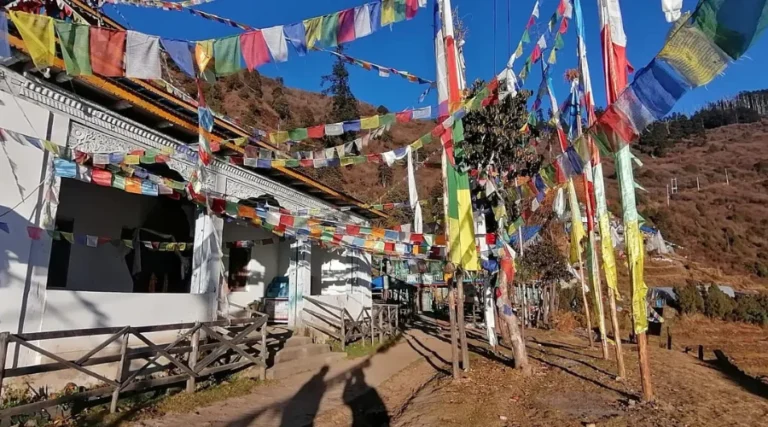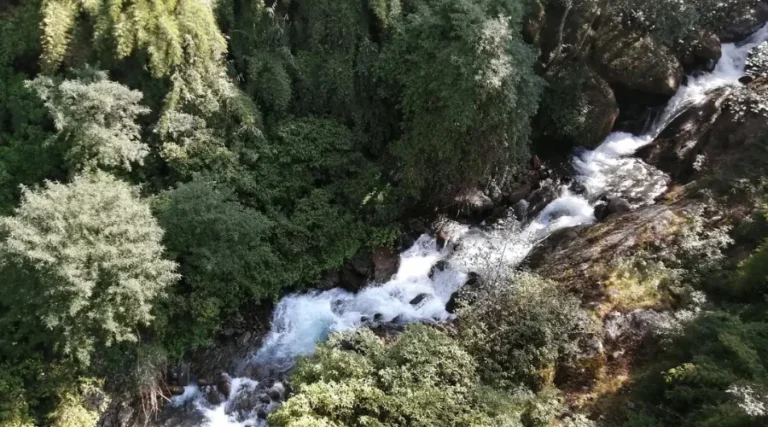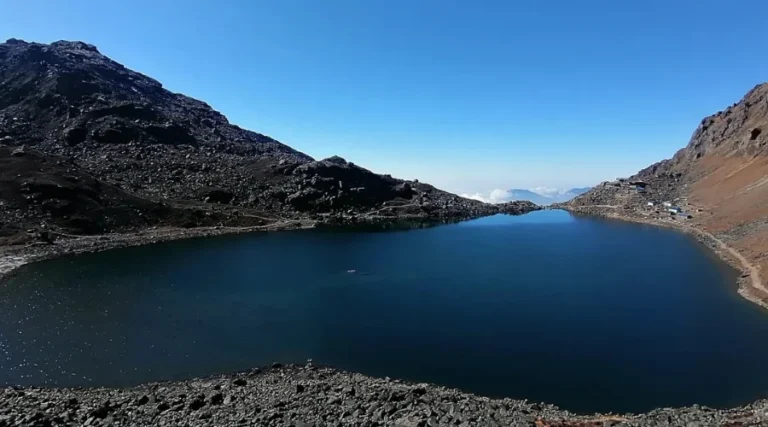Langtang Valley Trek
-

Trip Duration 09
-

Max, Altitude 3800 meters
-

Type Standard
-

Best Season Sept - May
-

Meals Included
-

Accommodation Guest House
-

Activity Trekking
-

Difficulty Easy
- The Langtang Valley Trek offers spectacular views of the Himalayas, including Langtang Lirung (7,227 m).
- Another tourist attraction is the village of Kyanjin Gompa, a Buddhist monastery.
- On the way back to Kyanjin, you will visit a yak cheese factory to taste homemade, warm, delicious yak cheese made from the milk of the yaks.
- The trek is accompanied by exposure to the typical and colourful Tamang and Tibetan settlements, where cultural exchange occurs.
- When hiking across the park, you will likely encounter some of the most extraordinary wildlife, including red pandas, the monal pheasant, and langurs.
- Those visitors willing to go a little further might consider a strenuous trek to Kyanjin Ri, one of the highest summits in the area at 4,773 m.
- Many regard this trek as more straightforward than others, mainly because fewer people hike in this area, which is one of the nearest trekking areas to Kathmandu.
The Langtang Valley Trek is one of the most beautiful treks in Nepal. It involves cultural and natural sightseeing and is moderately challenging at most.
This trek is easily and quickly accessible from Kathmandu, providing a fascinating view of the Himalayas without requiring a journey deep into the country.
Its local name is ‘the Valley of Glaciers,’ it has many glaciers above thousands of meters. Crossing the valley, you will meet villages where the principal inhabitants are the Tamang and the Tibetan.
Langtang Valley Trek is a cultural tour, and there are opportunities for tourists to explore the traditional lifestyle of the region’s people, artistic monasteries, and friendly people.
One of the trek’s unique features is Kyanjin Gompa, a hundred-year-old Buddhist monastery with spectacular views of Langtang Lirung (7,227 m) and other peaks.
Another attraction of the trail is the view of the Langtang Glacier, where the unadulterated natural surface of the earth is ice. The moderate trek suits those with little experience or who enjoy physical activity.
Langtang Valley Trek Difficulty
The trekking difficulty level of Langtang Valley Trek is moderate, which will give a lot of encouragement to those trekkers who are first-timers and also for those experienced trekkers after considering the preparation for the trek.
It does not have rock climbing but combines steep slopes, regularity and height, and it may be considered moderate. The trek takes 3,870m at Kyanjin Gompa, but you may add day treks such as Kyanjin Ri at 4,773 for additional altitude.
Acclimatization is essential to avoid altitude sickness; you quickly trek up after Syabrubesi here. It is common to have periods of inactivity throughout the planned endeavour to let the body acclimate. Daily trekking requires an average of 5-7 hours, good strength, and adequate endurance.
Anyone can do the trek with moderate physical activity tolerance, which can take up to 4 hours. The Langtang Valley Trek is thus ideal for first-time trekkers as it combines the extreme beauty of the Himalayas, as seen in other daunting treks, such as Everest Base Camp treks, but is not as tiring.
Short Itinerary
Itinerary of Langtang Valley Trek
Welcome to Nepal! You will be picked up by our representative at the airport who will also drop you off at the hotel. Overnight in Kathmandu.
We leave Kathmandu early for a drive to Syabrubesi. We drive along winding roads to finally reach Sybrubeshi. Enjoy nice views of Manaslu, Annapurna and Ganesh Himalen route. Once there we walk towards the tiny village of Syabrubesi. Overnight in Syabrubesi.
We trek along the LangtangKhola to reach the Lama Hotel. We go up and down through oak and rhododendron forests, thencross a brigde over the LangtangKhola, take on a steep trail and finally reach the Lama Hotel. Overnight in Lama Hotel.
We trek uphill enjoying the beautiful mountainous landscape and sparkly waterfalls. Soon we get glimpses of the Langtang range as we reach the green meadows of GhodaTabela. We clib further as the valley widens temporary herding settlements. We also pass a Buddhist monastery en route toLangtang village and then walk some more to reach Mundu. Overnight in Mundu.
With breakfast, we head for KyangjinGompa, one of the most important monasteries in the region. The trail is pleasant as we walk past prayer wheels, water mills, and chortens.
Today, we also get to see the enormous mani wall in Nepal, which is entirely made from stone and has sacred prayers written on them. We explore the area around Kyanjin Gompa and the Gompa itself while enjoying astounding views of the mountains.
Today, we set aside the day for acclimatization. We set off early, passed through yak pastures, and then ascended to the top of TserkoRi, where we witnessed an extraordinary sunrise view. We return to Kyanjin Gompa and explore the area some more.
We start retracing our steps today. We move downhill passing through beautiful lush forests and Tamang villages. This is also the chance to spot views we might have missed before. Overnight in Lama Hotel.
Back to the start! Our journey in the Langtang ends today. We trek to Syabrubesi and spend the night there.
With breakfast conquered we prepare for a drive back to Kathmandu. You can spend the rest of the day in Kathmandu packing or going souvenir shopping. A farewell dinner will be scheduled to celebrate the success of our trip. Overnight in Kathmandu.
This is it, your last day in Nepal. It’s time to say goodbye, but we hope we’ll meet again! Our representative will escort you to the airport three hours before the scheduled flight.
 Peak Season Notice!
Peak Season Notice!
As the peak season for Langtang Valley Trek, spring season in Nepal is on the way. All the trekkers shall book before to get the best reservations and packages.
Price includes
- Kathmandu Airport – Hotel – Airport transfer by Private vehicle
- Three Meals (Breakfast, Lunch and Dinner) during the trek
- Tea and Coffee during the trek
- Twin Sharing Accommodation at Kathmandu at 3 star hotel with breakfast
- Twin sharing accommodation during the trek
- National Park Entry Fee, Local Government Entry fee
- Transfer between Kathmandu – Sybrubensi – Kathmandu by public bus.
- 1 Experienced guide for the group of 2 to 10 and assistant guide for a group above 10
- One porter assigned for two people to carry luggage
- Our Staff’s daily meal, wage, equipment, insurance and allowances
- First aid kit with high-altitude medicines
- Duffel bag and Sleeping bag (Must be returned after completion of the trek)
- Trek completion certificate (Upon request)
- Our Service Charges
Price Excludes
- International airfare, Nepal Visa and travel insurance
- Meals in Kathmandu except breakfast
- Extra night accommodation in Kathmandu ( early arrival or flight cancellation etc)
- Personal expenses such as shopping, Laundry, Internet, Phone call etc
- Drinking water, cold drinks and alcohol drinks
- Gratuities for staff
Have any Questions? Check out FAQ'S
Trip Essential Information
Altitude Sickness in Langtang Valley Trek
The Langtang Valley Trek covers a height of up to 3,870m at Kyanjin Gompa, but you can climb higher to Kyanjin Ri at 4,773 meters, giving stunning views of the Langtang range.
The actual elevation is comparatively low compared to other treks in the Himalayas, but a steep climb within a short period may cause some altitude-related problems. Therefore, pleasure, drinking water, adequate sleep, and avoiding haste are essential.
Everyone trekking should note signs such as headaches or tiredness, mainly where the terrain is more challenging. This will help ensure a safe journey.
Meal during Langtang Trek
Food during the Langtang Valley Trek is simple and basic. Most of the trail offers teahouse meals consisting of vegetables, rice, noodles, and soup.
Breakfast consists of pancakes, eggs, porridge, or Tibetan bread. It also includes an exotic non-Veg Thukpa made of Tibetan noodles, rice, lentils, and vegetables, or fried rice with eggs, Tibetan bread, or noodles.
Vegetarian meals are easily found in the mountains, and it is widely suggested that people avoid meat in the hills to avoid problems with digestion. You can try a local delicacy in some teahouses: yak cheese, a specialty made from yak milk.
Drinkable water is available, but it should be treated with tablets or filters. Tea, coffee, hot ginger lemon honey, and other hot drinks are consumed to warm people up enough during cold climates in mountainous areas.
Accommodation in Langtang Valley Trek
Our meal and shelter on Langtang Valley Trek are several tea houses where you can get simple but standard meals and lodging. These teahouses are family-owned and operated, and the feel and the service you receive are typical of the region’s hospitality.
Accommodation is mostly twin sharing with a basic bed, blanket and pillow provided where necessary. However, comfort decreases as you go up.
Most of the time, showers are communal, and only those in the lower classes can afford the luxury of having water and a container with a showerhead at their disposal. It is possible to get hot showers at some extra charge; however, they use solar power or gas.
Lighting for charging devices is available, usually charged at a small amount for electricity tokens. Some teahouses have wifi, but the connection is poor, particularly in areas with high altitudes.
A typical day in Langtang Valley trek
The day on the Langtang Valley Trek starts early; you get up and have breakfast from any local teahouse. When you have done that, you will begin the hikes along beautiful terrains, which include forests, rivers and even villages.
The scenery one can get on the way is beautiful, and the probability of meeting such animals as red pandas or Himalayan pheasants is relatively high.
At about midday, you’ll stop for lunch at a teahouse on the trail and have time to shop. This is a good time to take some time off, get some rest, and have a good time in a natural setting. Depending on the later-day path, you’ll hike gradually up and down in the afternoon to the next stop-over point.
In the evening, they are either in a comfortable teahouse or will serve a warm dinner. Later, you can interact with fellow trekkers if you desire to relax or gaze at the beauty of the Himalayas and star-filled night sky before sleeping for the next trek.
Permits For Langtang Valley Trek
To trek the Langtang Valley, you will need the following Langtang Valley permits:
TIMS (Trekkers’ Information Management System) Card:
- The TIMS card eliminates everyone trekking in Nepal from dangerous activities and aids the trekker’s tracking system.
- One can get it from the Nepal Tourism Board, Kathmandu, Pokhara, or any registered trekking company.
Langtang National Park Permit:
- This permit is required since the trek is in the Langtang National Park.
- It can also be retrieved from the National Park Office in Dhunche, the entry point to the Langtang region and in Kathmandu.
- The permit grants one permission to enter the prohibited region to conserve the surrounding environment.
Travel Insurance
You must have travel insurance to trek to Langtang Valley, Nepal. It will help cover the costs related to emergencies, luggage, and services.
Evacuation is mandatory as the area may be inaccessible, and Aerial or other forms of transportation may be necessary for injuries, illnesses, or road accidents.
Because some insurance policies do not cover climbing and such activities in Nepal, it is advisable to check if your insurance covers high-altitude trekking.
Langtang Valley Trek Cost
Langtang Valley Trek cost with Himalayan Trekking and Tours is USD 630 per person. All your accommodation, food, permits and all will be covered.
For Nepali people, the Langtang Valley Trek cost usually ranges between NPR 15000- and NPR 25000.
Permits mainly cause this; foreign hikers must buy the Langtang National Park Permit and the TIMS card, which are cheaper for Nepalis only. In addition to the above, the cost of hiring a guide or a porter expands the general budget.
The trek is relatively cheap compared to other Himalayan treks, and for all the cultural experience, stunning views and exhilarating adventure into the Langtang Valley.
Best time for Langtang Valley Trek
The best time for the Langtang Valley Region is before the monsoon, from March to May, and after the monsoon, from September to November.
Spring is the best season for Langtang Valley Trek because the temperatures are moderate, and there is no precipitation; hence, it is suitable for a trek. Also, the trail goes through the rhododendron forests, which are spectacularly laid out during this time.
Autumn consists of a stable climate with fewer clouds. It gives excellent vistas of the Himalayas, with quite fresh but still relatively comfortable weather. It also ensures that the environment remains green, especially after the monsoons that dominate the region from the end of June to the end of September.
It is still possible to trek during the winter, December to February, or during the monsoon, June to August. Winter has low temperatures and snow at high altitudes, while monsoons make the trail dangerous due to regular rainfall.
Drinking Water
Pure water is essential while on a trek to the Langtang Valley, and the tap water in this region should be treated with much caution.
You can use water purification tablets, filters, or UV purifiers to ensure the water is safe. Most trekkers also prefer to buy bottled water at the teahouses. Though this is unhygienically damaging, it pollutes the environment; therefore, it is recommended that you bring your water purification method along.
Some other teahouses also sell boiled or treated water at an extra charge of a few yuan. With increased altitude, water availability is a challenge, and water prices are relatively high.
Wifi, Electricity And Communication during the Trek
Wifi:
Internet connection, particularly wifi, is available but in limited quantity along the Langtang Valley Trek. All the teahouses will provide wifi in Syabrubesi and Dhunche, but it can be slow sometimes.
During your climb to the Langtang Valley, the internet connection is limited to Wi-Fi only in certain areas. Internet connectivity in most teahouses established at higher altitudes is also limited, so expectations should be set accordingly.
Electricity:
Electricity is available, though not frequently, especially in the higher-altitude regions during the Langtang Valley Trek. In the lower areas facing the sun, installing teahouses with power from the national power supply or solar energy will be easier.
Yes, you can power your gadgets at the Teahouses, but there will be charges that you will be required to pay. The power bank is also recommended when you need to recharge devices on the hike because you may reach areas with harder-to-find charging points.
Communication:
Some teahouses provide satellite phones for rent to avoid situations that prevent reception and transmission of messages.
These services are handy during an emergency, but they are not cheap. Network coverage is a limiting factor; therefore, it is advisable to tell someone about your trekking plans before setting off and have a plan in case of emergencies.
Local NCell and NTC are available in the major cities. They will help you communicate correctly during the Langtang Valley Trek. You can even be busy with a data pack in case the Wi-Fi isn’t working in the region.
Frequently Asked Questions (FAQ)
Altitude sickness can be a concern, but our experienced guides will ensure proper acclimatization and provide the necessary guidance to minimize the risk.
You will stay in tea houses along the trail, which offer comfortable lodging and hearty meals.
Yes, permits are required for the Langtang Valley Trek. Two types of permits are necessary to accomplish the Langtang Valley Trek: the Langtang National Park permit and the TIMS Card permit. We will assist you with the necessary paperwork.
Yes, we can arrange for porters to carry your heavy backpacks, allowing you to trek comfortably with a light daypack.
The Langtang Valley Trek covers a total distance of about 77 to 95 kilometers (48 to 59 miles). And the the days actually depends on the specific route taken. The trek usually takes 5 to 9 days to complete, with daily hiking times ranging from 5 to 8 hours.
The Langtang Trek is actually a moderately difficult trek. It is a definite do-able trek. It is a great option for trekkers with average physical fitness and no prior trekking experience too.
The Langtang Valley Trek is definitely worth every bit. The whole trek has beautiful scenery, rich cultural experiences, and it has a manageable level of difficulty, making it a worthwhile adventure for anyone visiting Nepal for trekking experience.
Yes, the Langtang Trek is suitable for beginners. It is graded as a moderate trek. It does involve some uphill and downhill hiking, but most sections of the trail are manageable for those with average fitness levels. You don’t need prior trekking experience to complete the trek too. However, being physically prepared will definitely enhance your experience.
The best months for the Langtang Trek are during spring which is from March to May and autumn which is September to November.
As of April 2023, the government of Nepal has made it mandatory for all trekkers, including those on the Langtang Valley Trek, to hire a guide. This new regulation aims to enhance safety and ensure a better trekking experience for visitors.
Yes, people do live in the Langtang Valley. The local inhabitants, known as Langtangpas, primarily belong to the Tamang ethnic group and have a rich cultural heritage influenced by Tibetan Buddhism.
- Instant Confirmation
- Free to customize
- Support anytime
© 2025 - Himalayan Trekking and Tours (P) Ltd. All Rights Reserved.











 Peak Season Notice!
Peak Season Notice!

